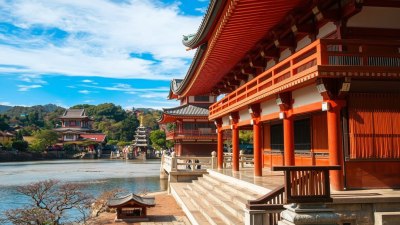The Music You Only Hear in Total Stillness in a Kyoto Temple
Explore the serene soundscape of Kyoto temples where silence reveals profound music.

Image created with Flux Schnell
Kyoto, the ancient capital of Japan, is a city steeped in history and culture, known for its stunning temples, meticulous gardens, and tranquil atmosphere. One of the unique experiences one can have in Kyoto is the profound sense of music that emerges in total stillness at its temples. While you may expect to hear the chants of monks, the rustle of leaves, or the distant sound of a bamboo fountain, there is a subtler kind of music that can only be experienced in moments of deep quietude.
When you step into a temple in Kyoto, you are enveloped by an ambiance that invites introspection. Temples like Kinkaku-ji, the Golden Pavilion, and Ginkaku-ji, the Silver Pavilion, offer not just breathtaking visual beauty but also spiritual solace. These sacred spaces are designed for meditation and reflection, allowing visitors to disconnect from the chaos of the outside world. This is where the real music begins.
The Art of Silence
Silence is often misunderstood; it is not merely the absence of sound but a presence in itself. In the stillness of a Kyoto temple, silence can be profound, giving way to a soundscape that is both ephemeral and transient. The whispers of the wind through the trees, the subdued rustle of a robe as a monk walks past, and the gentle trickle of a waterfall create an orchestra of natural sounds. However, it is the silence in between these sounds that resonates deepest.
To truly appreciate the music of silence, one must learn to listen actively. This means being fully present in the moment, allowing thoughts to drift away, and opening up the senses to the subtle vibrations in the environment. The blend of nature and the sacred architecture within temples creates a unique acoustical environment where even the faintest sounds can evoke powerful feelings.
The Sound of Nature
Kyoto's temples are often surrounded by meticulously curated gardens filled with flora native to the region. The coalescence of nature and spirituality manifests through the sounds of birds chirping, leaves rustling, and the distant sound of water. These elements contribute to what can be described as the music of nature. For example, the sound of wind breezing through a pine forest can create harmonies that reflect the gentle undulation of air. Similarly, the call of a distant temple bell strikes a chord that reverberates through the tranquil surroundings.
Additionally, the sounds of nature change with the seasons. In spring, cherry blossoms bloom, and their petals flutter down like glistening snowflakes, creating a soft sound that is almost magical. In summer, cicadas sing their incessant song, providing a lively rhythm that dances through the air. Autumn brings the crunch of leaves underfoot, while winter blankets the city in snow, muting sound and creating an ethereal quiet that is both peaceful and melancholic. This variability reflects not just the cycle of nature but also the passage of time, allowing one to meditate on the impermanence of life.
Chants and Mantras: The Human Element
Though the music of silence is prevalent, human elements also contribute uniquely to the soundscape of Kyoto temples. Monks often recite sutras and chants, their rhythmic patterns resonating in the halls. These chants are not just spoken words; they are a form of musical expression that transcends language. The melodic intonations, the rise and fall of their voices, imbue the environment with a palpable spiritual energy.
Visitors may have the opportunity to participate in zazen, a form of seated meditation practiced within these temples. During zazen, silence envelops the room, allowing for individual reflections. Yet, even in this silence, the collective breathing of participants creates a gentle harmony, underscoring the connection between individuals within the sacred space. Thus, even the act of meditative silence transforms into a shared musical experience.
Mindfulness and Awareness
Practicing mindfulness in such serene environments allows us to cultivate a heightened awareness. This mindfulness not only enhances our perception of sound but also our connection with the surroundings. When one is completely mentally present, the slightest shifts in atmosphere can be perceived as musical notes. The sunlight filtering through stained glass can create a dancing shadow that feels like a visual melody, while the scent of incense wafting through the air may evoke deep feelings of nostalgia.
Moreover, engaging in mindful practices such as slow walking meditation among temple paths allows one to attune to the earth beneath the feet. The soft crunch of gravel pathways and the gentle swaying of branches above create a continuity of sounds that becomes a personal symphony. This practice emphasizes that music exists all around us; it is a matter of perception and openness to the world.
The Changing Soundscape
As Kyoto has evolved, so has the auditory landscape of its temples. The bustle of the modern world encroaches upon these sacred retreats, yet within the walls of the temples, one can still find pockets of peace, even amidst the noise. Techniques such as soundscape ecology study the natural sound environments and how they impact human well-being. Within the context of Kyoto's temples, understanding these layers of sound helps us appreciate the unique auditory narratives that are woven within these sacred spaces.
As temples thrive on heritage and are constantly evolving with society's needs, there are initiatives by temple administrators to create environments that preserve natural sounds while limiting disruptive modern sounds. This harmony between preserving tradition and adapting to contemporary needs allows the temples to remain sanctuaries of repose, where the music of silence can still be heard.
Personal Reflections
A visit to a Kyoto temple isn't solely about the visual experience; it offers an opportunity for personal reflection and self-discovery. By actively engaging with the soundscape, visitors can find their inner voice amidst the external silence. Each individual's resonance with these sounds is unique and personal. For some, it may invoke feelings of calm and peace, while others might experience a stirring of emotions long buried.
Keeping a journal to capture these experiences can be incredibly rewarding. Describing how the silence felt, what thoughts arose, or how a particular sound stirred memories can serve as a powerful reminder of this unique experience long after returning home. Documenting these personal insights becomes a form of music in itself, a narrative that captures the essence of the experience.
The Lasting Impact of Silence
In conclusion, the music you hear in total stillness in a Kyoto temple is a reflection of the intricate relationship between sound and silence. Each visit invites one to rediscover the beauty that comes not just from what is heard but from what is felt. By surrendering to the silence, we open ourselves to listening more deeply—not only to the world around us but also to the thoughts and emotions within us.
The temples of Kyoto remind us that profound music exists in many forms, often in the stillness of our surroundings. The true essence of this music is found in the moments of quiet reflection, where nature, spirituality, and human experience intersect. As you navigate the serene paths of a Kyoto temple, take a moment to pause, breathe deeply, and immerse yourself in the music of silence. This experience may just be one of the most profound melodies of your journey.











